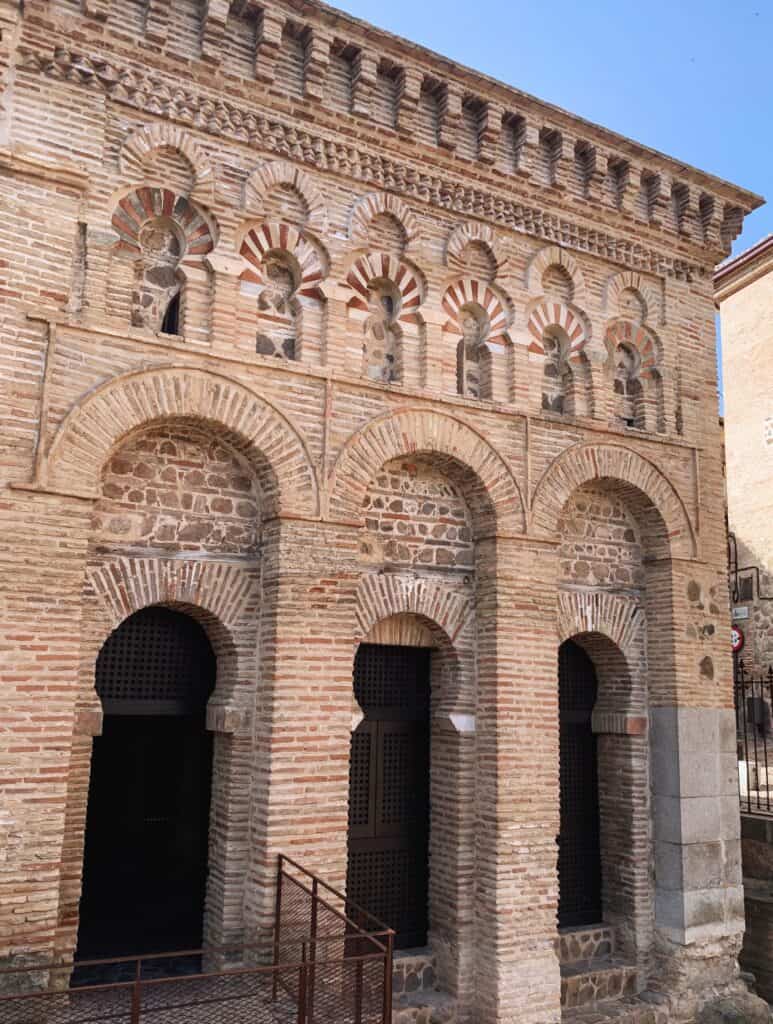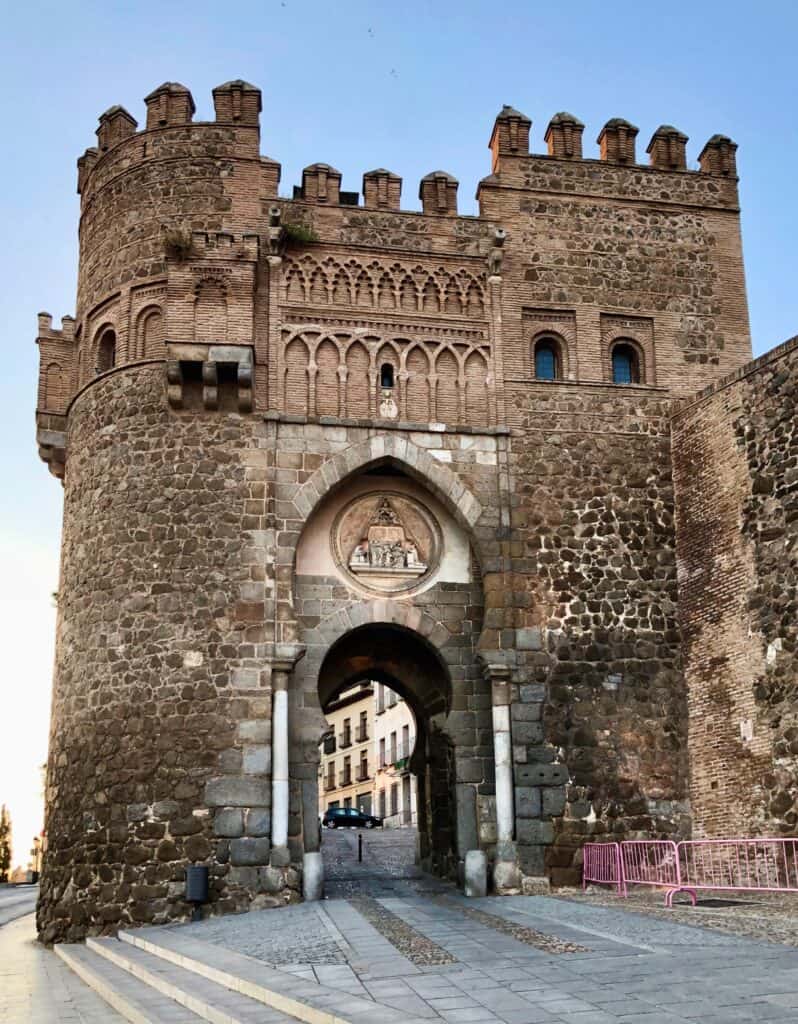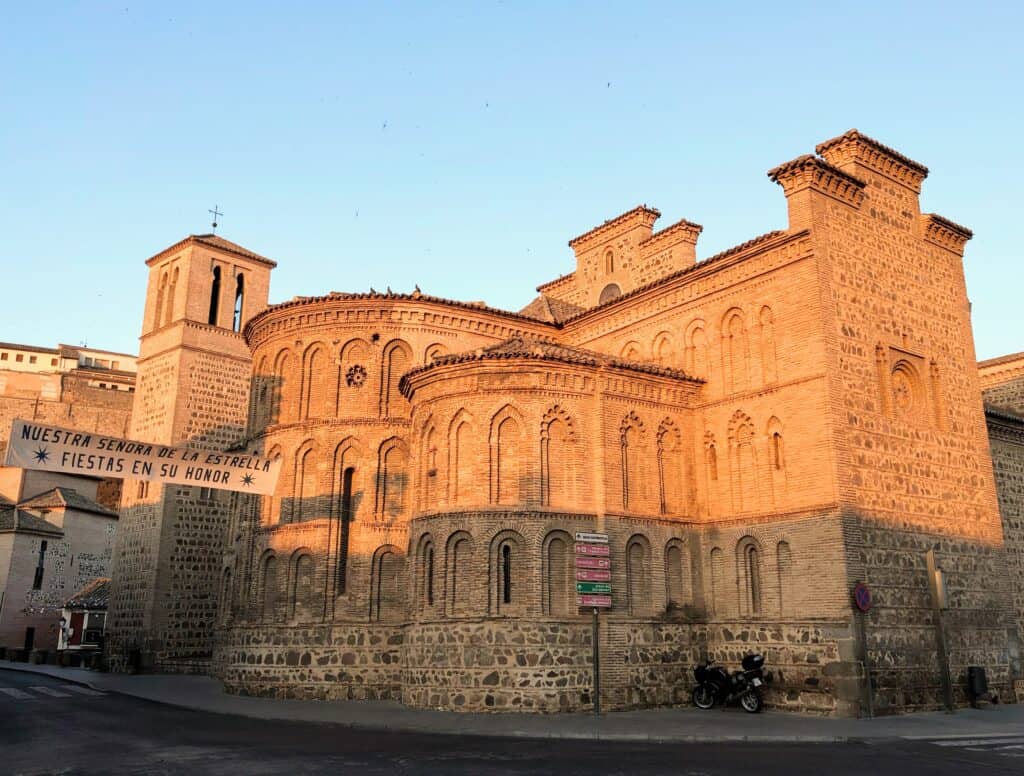The Mosques, Synagogues and Churches of Toledo, Spain
Toledo’s Muslim heritage permeates the city, from its layout of tiny, winding streets oriented to keep it cool to the Arabic inscriptions within its fortified walls and gates. Even though the Christian Reconquista hit Toledo fairly early, its buildings retain the local Mudéjar style. Most of the city’s architecture took its cues from Islamic monuments like Granada’s Alhambra rather than from French Gothic cathedrals. Muslim, Jewish, and Christian structures alike show the impact of Moorish Spain on an intimate scale.

Medieval Spanish history ran the gamut from tolerance to persecution, and vocabulary can be delicate. The term Mudéjar originated as a reference to Muslims living under Christian rule in Iberia and sometimes carried negative connotations. Later, historians adopted the term to describe art and architecture incorporating elements from mosques and other Andalusian structures. These include horseshoe and interlacing arches, as well as Arabic inscriptions and a preponderance of geometric and plant motifs. Medieval synagogues and churches adopted the style developed in mosques, and “Mudéjar” culture came to represent the region as a whole.
The following monuments represent some of the most notable Mudéjar buildings in Toledo. Click on a link below to jump to a specific building. All sites are marked on our Google map.
Cristo de la Luz (Mosque of Bāb al-Mardūm)
Mosque & Church of El Salvador
Synagogue of Santa María la Blanca
El Tránsito (Synagogue Samuel Ha-Leví)
Church of Santiago del Arrabal
Toledo as a Cultural Force in Medieval Europe
When Muslims conquered the Iberian Peninsula in the eighth century, the city of Córdoba eclipsed the old Visigoth capital of Toledo. But when the Córdoban government dissolved early in the 11th century, Toledo regained some of its former prominence as one of Spain’s most powerful city-states. Without the patronage of a central court, intellectual life spread to smaller cities – and regional leaders competed for cultural as well as military supremacy.

In the constantly-shifting series of alliances and rivalries, the three faiths of Islam, Christianity, and Judaism mixed as never before. Toledo attracted scientists as well as a community of linguists, who began translating texts collected in Córdoba. While the rest of Europe struggled through the Dark Ages, Muslims not only preserved the great works of antiquity but made tremendous advances of their own. Thanks to the scholars of Toledo, this knowledge would soon become available to the rest of the western world.
Cristo de la Luz (Mosque of Bāb al-Mardūm)
When Alfonso VI of Léon took control of Toledo in 1085, Christians tore down the Great Mosque in the center of town so they could use the site for a church. Muslim worship shifted to the town’s outskirts, focusing on smaller mosques like the Bāb al-Mardūm near the Puerta del Sol gate. This mosque, constructed in 999, remained unaltered until the king gave it to the Knights Hospitaller around 1185. The knights maintained the original style of architecture when adding the rounded section on the end, consecrating it as the Chapel of the Holy Cross. At some point it picked up the common name, Christ of the Light.

The current structure retains much of the original mosque. The exterior shows Andalusian brickwork at its most skillful and inventive, in configurations one has to see to believe. For instance, the street façade uses bricks in every possible orientation to make various arches, as well as a border of jagged surfaces and a band of delicate, net-like openings. Remarkably, the strip of irregularly-placed bricks near the roof forms an inscription.

On the inside, the mosque’s prayer hall packs a surprising amount of drama into a mere eight x eight meters (about 25 feet per side). Four columns salvaged from a Roman/Visigoth structure divide the space into nine squares, each topped by a small ribbed dome. Each dome features a different configuration of multi-tiered vaulting: three replicate the maqsura in Córdoba’s Great Mosque, and six are variations. Traces of paint indicate that the interior was originally multicolored.


When the Knights converted the building into a church, they tore down the quibla (prayer wall) and extended the building to make a semicircular apse. The distinction between the new and old sections is more prominent on the interior. However, even the more overtly Christian areas mix in accents derived from the region’s Islamic past. The great dome of the apse features a Christ Pantocreator fresco, but the arch leading to it is painted with a traditional Arabic inscription. Ringing the lower apse, horseshoe niches were designed to hold images of saints.

As symbols of paradise, gardens hold a sacred role in Islamic architecture. The Mosque of Bāb al-Mardūm features a patio in front with a view of the valley below.
Admission €3 or free with Toledo tourist bracelet pass – for more information, see website. Calle Cristo de la Luz, 22. Daily 10-6:45 March 1-October 15, and 10-5:45 October 16-February 28.
Puerta del Sol

Just steps away from the Cristo de la Luz, the Puerta del Sol extends the same Mudéjar style to one of the main city gates. The Knights Hospitaller worked on both structures at in the closing decades of the 12th century. For the Puerta del Sol, they rebuilt an older gate and tower into a surprisingly complex set of spaces encompassing each level of the hillside site. Spectacular architecture and grand views help it maintain a commanding presence, even though it’s now cut off by a modern road.
Callejón San José, 2.
Mosque & Church of El Salvador
Few buildings can compare with the layers of history condensed into the Salvador. The site originally held a second-century Roman structure, which the Visigoths converted to a church during their rule in the sixth and seventh centuries. Vestiges of these early periods remained after the early ninth century when it became a mosque, most notably the re-use of Roman/Visigoth columns and capitals under the horseshoe arches. Finally, Christians turned it back into a church around 1159, adding a nave and turning the minaret into a bell tower.

In the first decades after 1085, this building became Toledo’s congregational, or “Friday”, mosque. As such, it needed to be able to hold the entire male Muslim community for Friday prayers. To get a sense of how many Muslims must have left the city by then, compare the Salvador’s size to Toledo’s mammoth Gothic cathedral occupying the foundations of the old Friday Mosque.
Admission €3 or free with Toledo tourist bracelet pass – for more information, see website. Plaza el Salvador. Daily 10-6:45 March 1-October 15, and 10-5:45 October 16-February 28.
Synagogue of Santa María la Blanca

Santa María la Blanca might be the oldest surviving synagogue in Europe, although not everyone agrees on 1180 as a construction date. Throughout history, many synagogues have adopted regional architectural styles, and this one presents a stunning blend of predominantly Islamic influences with some unique additions. Almohad Muslims controlled much of Spain in the 12th century, and this building borrowed their austere sensibility and extensive use of white. Like traditional mosques, it features a hall of columns connected by rows of horseshoe arches. Here, however, the columns are octagonal rather than round, and made of stucco, like the arches. In between, ornate capitals of beige stone evoke both Greek Corinthian and Byzantine forms but ultimately look like nothing ever seen before. They also incorporate pine cones, a traditional Jewish symbol.


Carved geometric friezes over the arches echo Granada’s architecture, as does the row of small polylobed arches above. The latter have since had their openings filled in, necessitating artificial lighting during the day. Floodlights set into the floor slowly alternate between cool and warm white, emphasizing the space’s purity.
Christian persecution of Jews amplified over time, and the synagogue was sacked during a 1391 massacre. The Order of Calatrava converted it into a church not long afterwards. At various points, it also functioned as a barracks, a warehouse, and a dancehall. Today the space functions as a museum rather than a house of worship, although the Roman Catholic archdiocese retains ownership.
Admission €3 or free with Toledo tourist bracelet pass – for more information, see website. Calle de los Reyes Católicos, 4. Daily 10-6:45 March 1-October 15, and 10-5:45 October 16-February 28.
El Tránsito (Synagogue Samuel Ha-Leví)
As diplomat, finance minister and adviser to the king, Samuel Ha-Leví Abulafia used his power to lobby for the Jewish community, founding a number of synagogues. None was as grand as the one he had built for his own use in Toledo.

By the 14th century, synagogues weren’t permitted to rise above churches or compete with them in splendor; some scholars think that King Pedro made an exception here as a gesture of reconciliation with the Jews in Toledo, who had been scapegoated for the Black Death in 1348.
Abulafia’s close relationship with Pedro had a profound influence on his synagogue, not least because it was built at roughly the same time as the king’s additions to the Alcázar in Seville. Both men wanted to express power, authority, and taste – and they both chose to do so via the architecture of Granada’s Muslim kings. Painted stucco carved into delicate forms, intricate geometric window grilles, and frilly arches span the walls. Abulafia purportedly shipped cedar all the way from Lebanon for the elaborate ceiling inlaid with ivory.


The synagogue is perhaps most famous for its inscriptions in Hebrew and Arabic. The use of written words to adorn buildings had long since spread beyond mosques, but multilingual quotations in architectural settings had a special significance for Jews, who formed the core of Toledo’s community of translators.
Abulafia’s synagogue managed to survive until the 1492 expulsion of Jews from Spain. Although it had to be reconsecrated as a church, the only major alteration to the building was the addition of a belltower in the 16th century. It even retains the three niches for holding the Torah scrolls.
The name Nuestra Señora del Tránsito refers to one of its paintings, now in Madrid’s Prado Museum. Today the structure houses the Museo Sefardi (Jews living in Spain prior to 1492 were called Sephardim).
Admission €3. Calle Samuel Levi. March-October: Tuesday-Saturday 9:30-7:30, Sundays & holidays 10-3. November-February: Tuesday-Saturday 9:30-6, Sundays & holidays 10-3.
Church of San Román
At one of the highest spots in the city, the Church of San Román was built early in the 13th century on the site of a Visigoth church, which itself occupied an old Roman building site. Although the building held some Islamic tombs until the late 16th century, no evidence has been found to show it was used as a mosque.

The exterior is typical of Toledo’s medieval architecture, which makes the wild interior even more of a surprise. Layer upon layer of elements from seemingly every period of Iberian history mix together: ancient columns, Visigoth carvings, red-and-white horseshoe arches inspired by Córdoba, medieval heraldry, Biblical frescoes, an ornate Baroque dome lined with figural reliefs, and plenty more.

San Román takes Islamic styles beyond their original context, with sometimes-ambiguous results. The prominence of the striped arches seems to be celebrating Muslim heritage, but using pseudo-Arabic inscriptions signals that it was no longer relevant.
The church now houses the Museum of Visigothic Culture. Admission €2. Calle de San Román, Tuesday-Saturday 10-2 & 4-6, Sunday 9-3.
Church of Santiago del Arrabal

Extensive restorations in the twentieth century liberated this structure’s original Mudéjar core from successive additions. The result is one of the most cohesive – and striking – buildings in Toledo. The site first held a mosque, which was reconsecrated and used as a church until the 13th century. At that point, everything but the tower was rebuilt using the same style as the Cristo de la Luz.

Given the Islamic influences in the architecture, the church’s dedication to Santiago seems ironic: Saint James was revered by Christians for helping them in a battle against the Moors. Arrabal is the name of the neighborhood adjacent to the Puerta Bisagra.
Plaza Santiago del Arrabal, 4.
Further Reading
Our other post on Toledo includes an overview of the city’s architecture and sights.
We also have posts on Spain’s Islamic architecture, Córdoba’s Mezquita (a.k.a. the Great Mosque), Islamic architecture in Seville, Granada’s Albaicín district, and the Alhambra.

